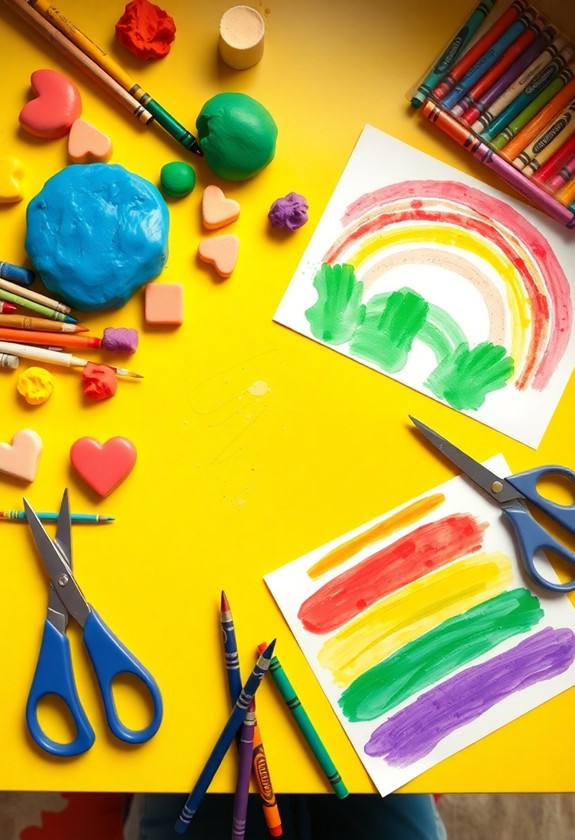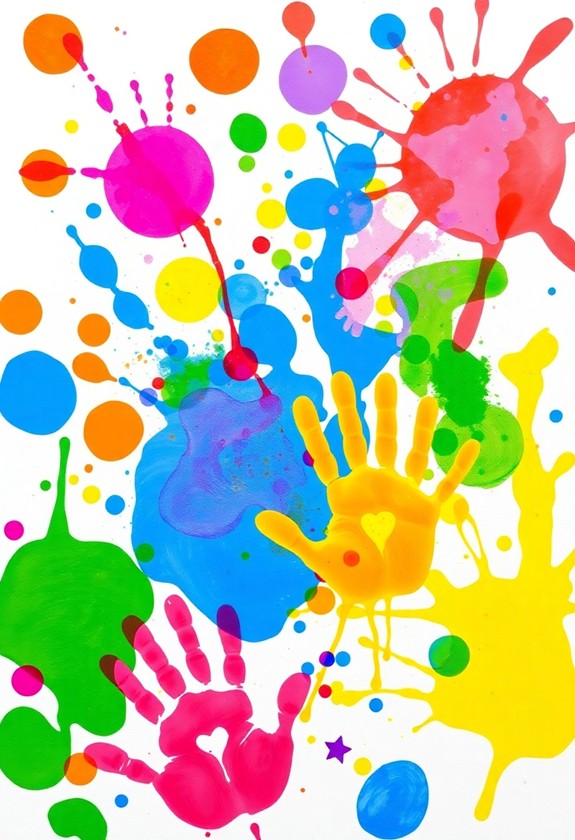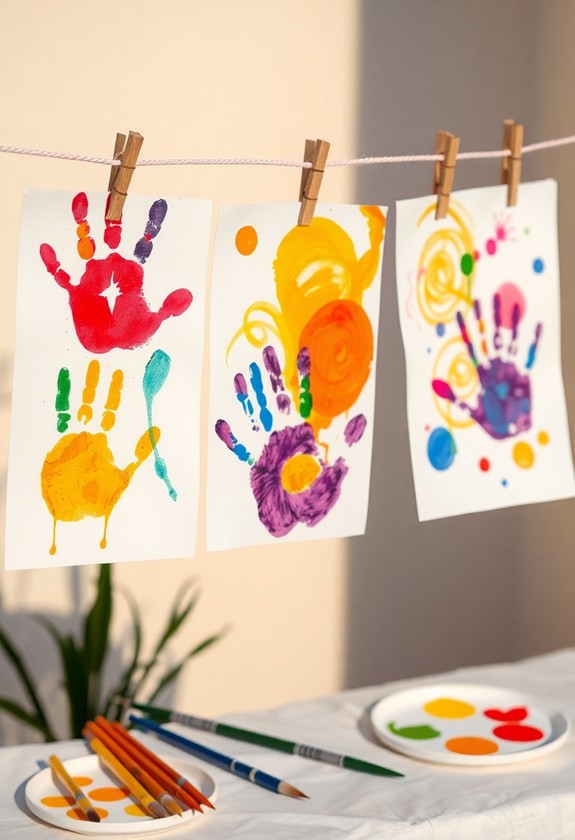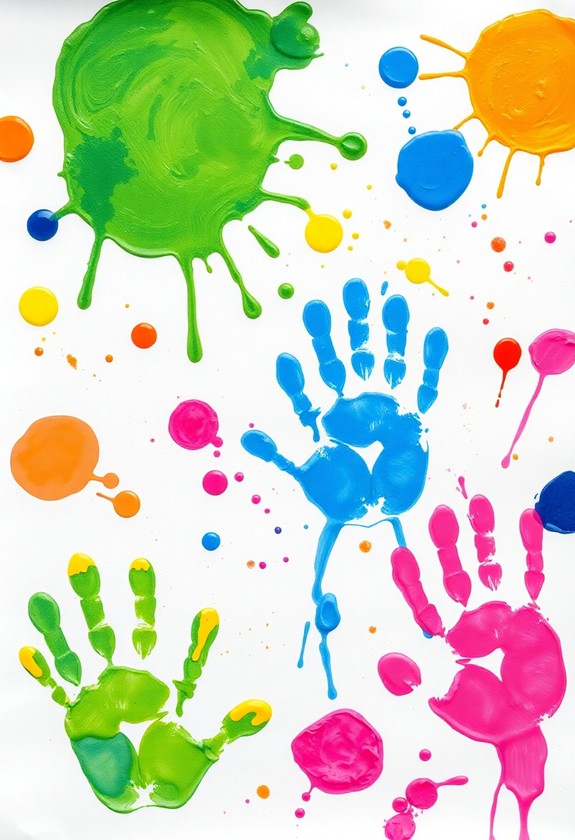Get ready to reveal your toddler's inner artist as you enhance their motor skills! Try these fun activities: finger painting for sensory exploration, Play-Doh sculpting for creativity, sticker collages for decision-making, sidewalk chalk drawing for outdoor fun, paper tearing and gluing for texture play, pom-pom sorting and gluing for color recognition, watercolor with eyedroppers for hand-eye coordination, beading necklaces for focus, and Q-tip pointillism for grip strength. These projects aren't just about making masterpieces – they're about developing essential skills! Your little one will be having so much fun, they won't even realize they're learning. But wait, there's more to uncover about each exciting activity!
Creative Highlights
- Finger painting develops fine motor skills while encouraging creativity and sensory exploration in toddlers.
- Play-Doh sculpting enhances fine motor skills through shaping and molding activities, fostering imaginative play.
- Sticker collage creations improve hand-eye coordination and decision-making skills in a mess-free art experience.
- Beading necklaces and bracelets engages toddlers while boosting fine motor skills and confidence through wearable art.
- Q-tip pointillism paintings develop grip strength and hand-eye coordination while introducing a unique art technique.
Finger Painting Fun
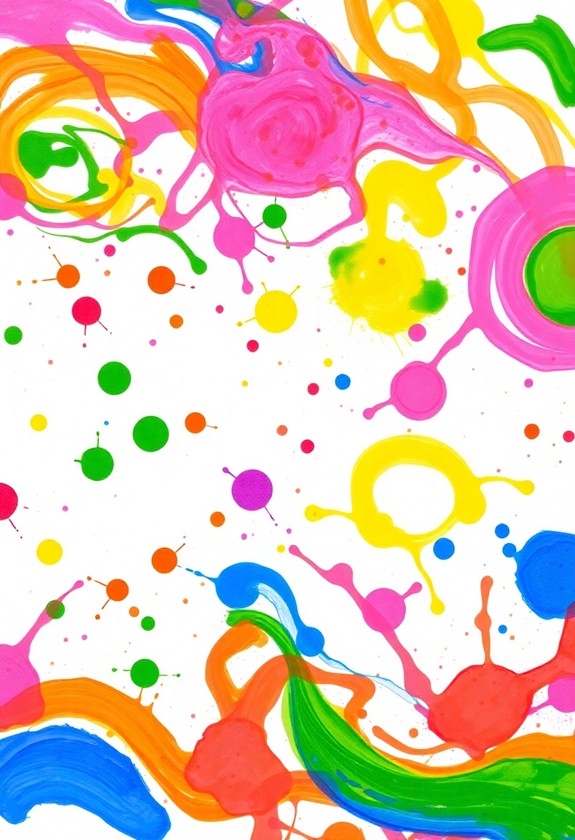
Creativity flourishes when little hands plunge into lively colors. Finger painting is a messy, magical adventure for toddlers! It's not just fun—it's fantastic for developing fine motor skills and sensory exploration. This sensory-rich activity can be especially beneficial for children with Sensory Processing Disorders, helping to reduce anxiety and promote sensory integration. Here's how to get started:
- Gather supplies: non-toxic finger paints, large paper, and a washable surface
- Dress your little one in old clothes or a smock
- Squirt dollops of paint onto the paper
- Let the colorful chaos begin!
Encourage your tot to swirl, smear, and squish the paint. They'll love the squishy sensations and lively hues! Try these exciting variations:
- Mix colors to create new shades
- Add texture with sponges or leaves
- Paint on different surfaces like cardboard or foil
Play-Doh Sculpting Adventures
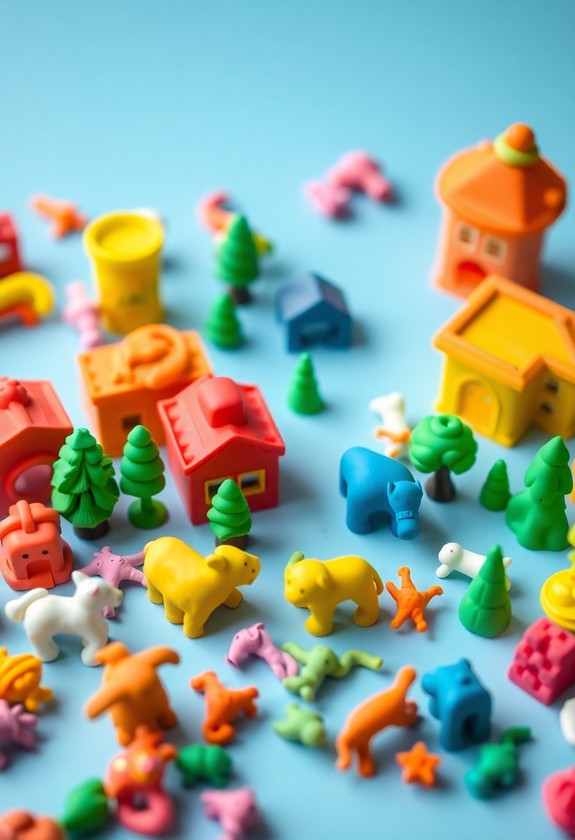
From squishy paints to moldable dough, we're moving on to another tactile treat for tiny hands. Play-Doh is a toddler's dream come true! It's time to sculpt, squish, and shape your way to fun! Play-Doh offers non-toxic and washable options, ensuring safe and mess-free creative play for your little ones.
Get ready for some doughy delight with these Play-Doh adventures:
- Animal parade: Roll, pinch, and mold creatures big and small!
- Colorful food fest: Whip up a pretend meal that looks good enough to eat!
- Letter and number practice: Shape the alphabet or count with squishy digits!
Don't forget to:
- Mix colors for exciting new shades
- Use cookie cutters for perfect shapes
- Roll out "snakes" and coil them into spirals
Play-Doh isn't just fun—it's fantastic for fine motor skills! Watch those little fingers work as your tot creates masterpieces. And remember, there's no right or wrong in Play-Doh land. Let imagination run wild!
Sticker Collage Creations
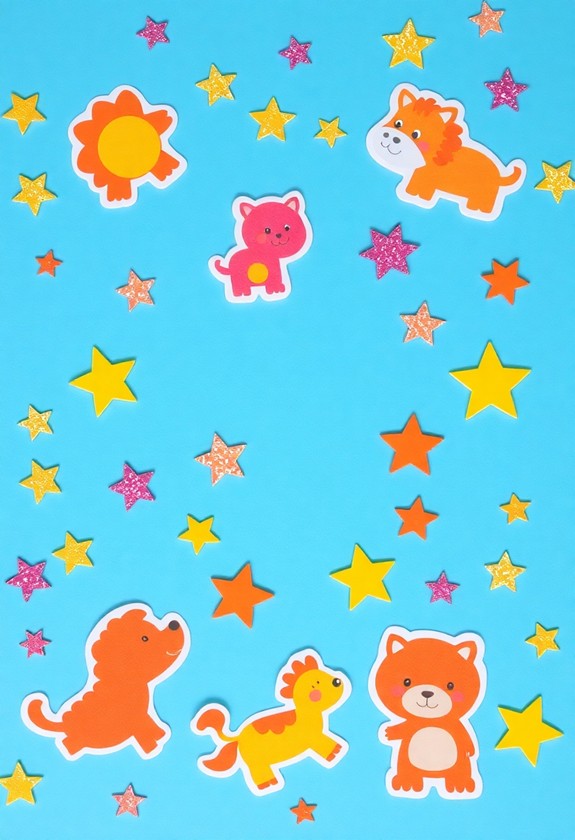
Imagination soars with the sticky, colorful world of sticker collages! You'll love watching your little one's creativity blossom as they peel and stick their way to masterpieces. Here's how to get started:
- Gather supplies: sticker sheets, paper, and a flat surface
- Let your toddler choose their favorite stickers
- Encourage them to peel and stick freely on the paper
Watch as tiny fingers work their magic, developing fine motor skills with each sticker placed. This activity promotes decision-making and improves hand-eye coordination, supporting your child's cognitive development. It's a stick-tacular adventure! But wait, there's more:
- Mix it up with different sticker shapes and sizes
- Create themes like "jungle animals" or "outer space"
- Use construction paper for colorful backgrounds
Your little Picasso will be sticking up a storm in no time! And the best part? No mess to clean up afterward. It's a win-win situation that'll have you both stuck on this activity!
Chalk Drawing on Sidewalks
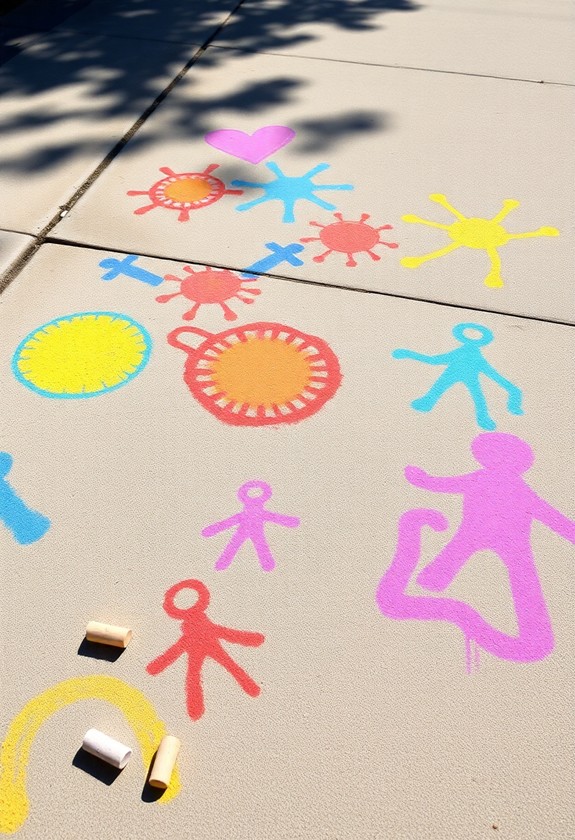
When the weather's nice, sidewalk chalk drawing offers a fantastic outdoor art experience for toddlers. It's a super fun way to boost their motor skills and release creativity! Using non-toxic, washable crayons or chalk guarantees easy clean-up and peace of mind for parents. Here's how to make the most of this colorful activity:
- Choose a safe, flat area on your driveway or sidewalk.
- Provide chunky, easy-to-grip chalk in various colors.
- Encourage your little one to draw freely – scribbles, shapes, or anything they imagine!
Don't forget to join in the fun! Draw outlines for them to color in, or create hopscotch boards for added excitement. And here's a neat trick: use a spray bottle with water to create a "paint" effect with the chalk. It's like magic!
Tearing and Gluing Paper Art
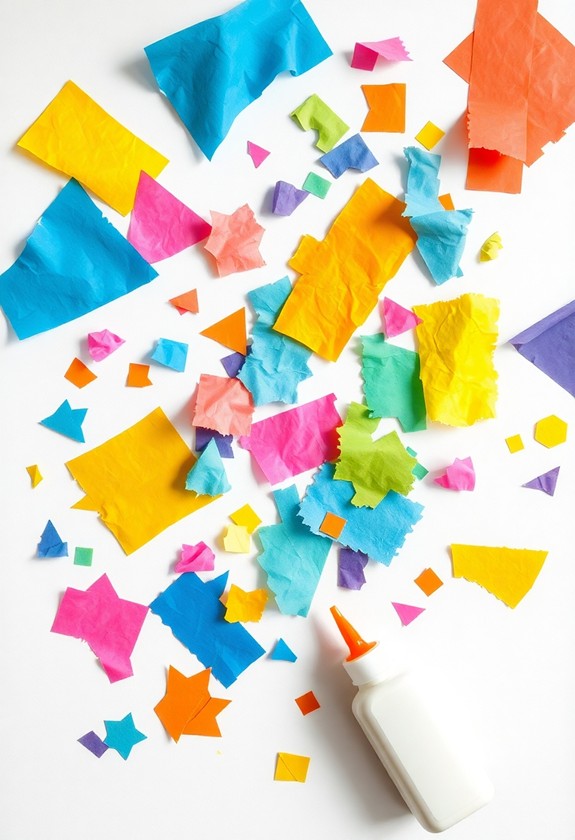
Tearing and gluing paper art offers toddlers a delightful sensory experience during developing their fine motor skills. It's a blast! Your little one will love ripping colorful paper into shreds and sticking them onto a canvas. This activity enhances creativity and provides a medium for self-expression, allowing toddlers to investigate their artistic side. Here's how to get started:
- Gather supplies: construction paper, glue sticks, and a sturdy base
- Let your tot tear paper into small pieces (watch those tiny fingers go!)
- Show them how to apply glue to the base
- Encourage them to stick paper bits wherever they want
Voila! A masterpiece is born. This activity isn't just fun, it's fantastic for developing hand-eye coordination and grip strength. Plus, it's a great way to introduce basic shapes and colors. So, get ready for some "tear-ific" art time with your toddler!
String Painting Experiments
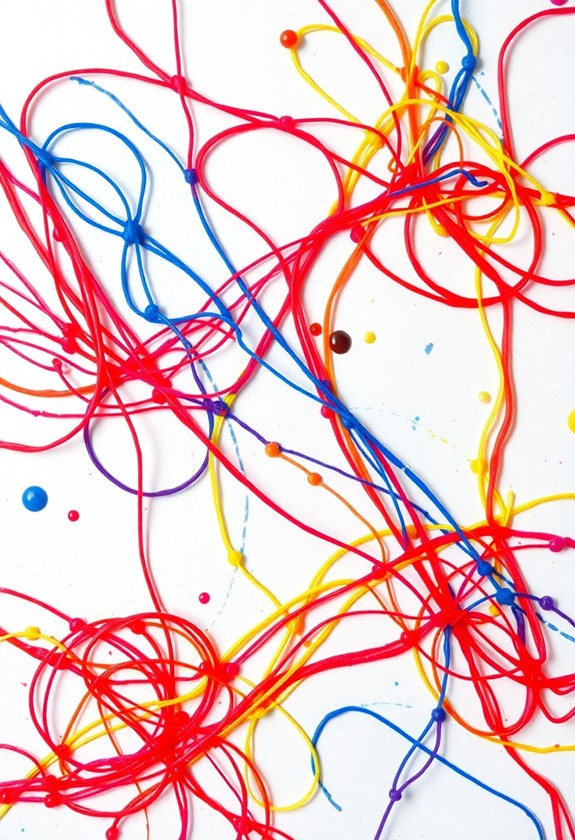
Dipping into the world of string painting opens up a messy but magical art experience for toddlers. It's a fantastic way to boost their fine motor skills and creativity! Here's how to get started:
- Gather supplies: string, paint, paper, and scissors
- Cut string into 12-inch lengths
- Pour different colors of paint onto plates
- Let your little one dip the string in paint
- Place the string on paper and fold it in half
- Pull the string out as you press down – voila!
Watch as your toddler's eyes light up with each colorful creation! They'll love the unpredictable patterns and swirls. But wait, there's more! Try these string-tastic variations:
- Use multiple strings at once
- Experiment with different paper colors
- Add glitter for extra sparkle
Get ready for a string of fun art adventures!
Pom-Pom Sorting and Gluing
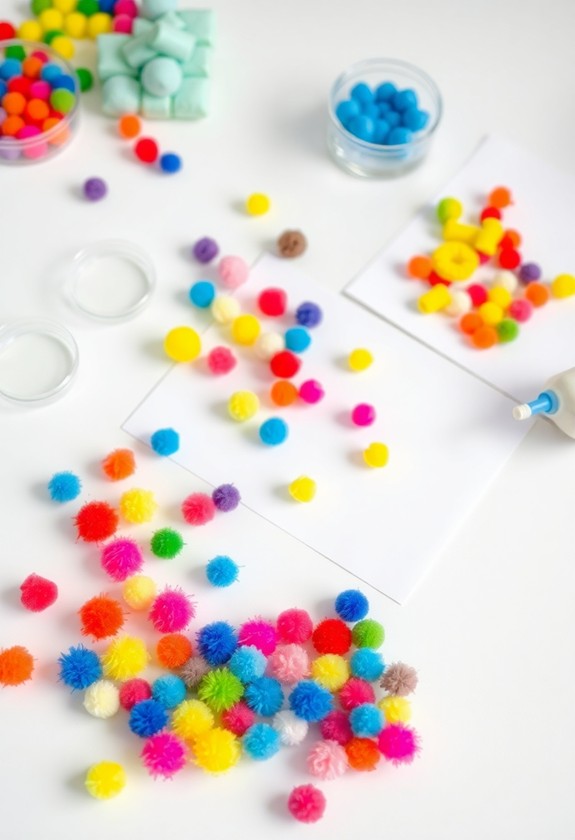
Colorful pom-poms offer a delightful tactile experience for toddlers during teaching important skills. They're perfect for sorting and gluing activities that'll boost your little one's fine motor development and color recognition. Get ready for some pom-pom fun!
Start by gathering these materials:
- A variety of colorful pom-poms
- Glue sticks or child-safe liquid glue
- Sturdy paper or cardboard
First, let your toddler sort the pom-poms by color. It's a pom-tastic way to learn! Then, draw simple shapes on the paper and help them glue pom-poms along the lines. Watch as their masterpiece comes to life!
For an extra challenge, try creating patterns or specific designs. Your tiny artist will have a ball experimenting with textures and colors. Remember, the process is more important than the result, so let their creativity pom-pom!
Watercolor With Eyedroppers
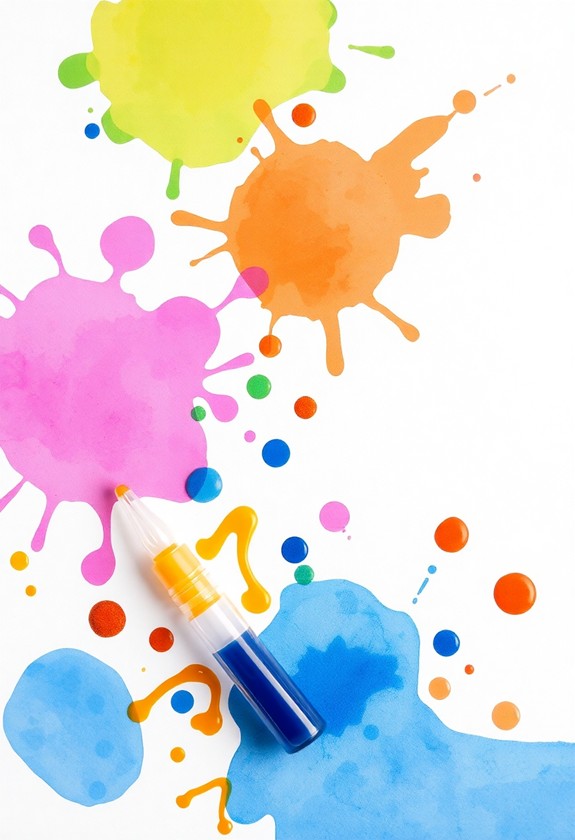
Watercolor painting takes on a new twist with this exciting eyedropper technique. You'll love watching your toddler's eyes light up as they create colorful masterpieces! Here's what you need:
- Watercolor paper
- Liquid watercolors
- Eyedroppers
- Small cups for paint
Start by pouring different colors into separate cups. Show your little artist how to squeeze the eyedropper's bulb, suck up the paint, and release it onto the paper. Wow! Look at those lively splashes and droplets! Encourage them to experiment with:
- Mixing colors
- Creating patterns
- Tilting the paper to make drips
This activity is a blast and helps develop fine motor skills and hand-eye coordination. Plus, it's a great way to introduce color mixing concepts. Your tiny Picasso will be dropping with excitement as they create their liquid masterpieces!
Beading Necklaces and Bracelets
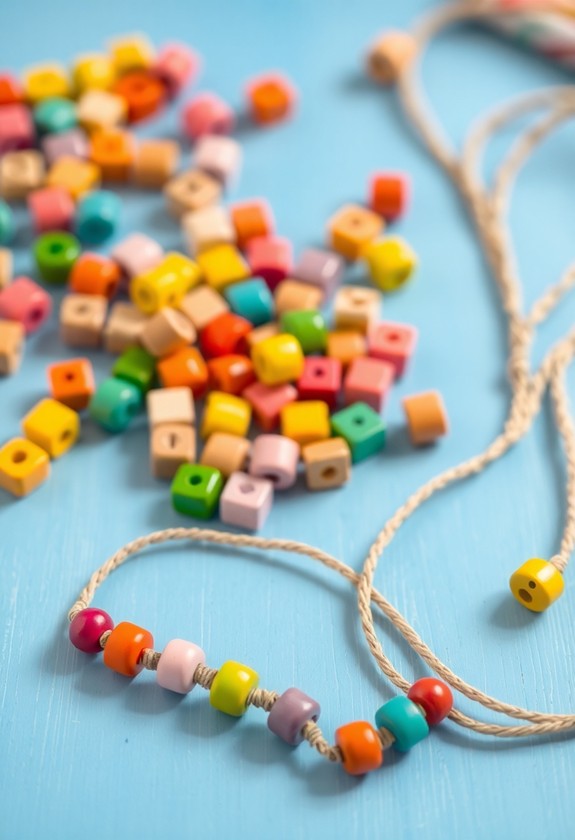
Beading necklaces and bracelets offers toddlers a fantastic opportunity to improve their fine motor skills as they create wearable art. It's a fun, engaging activity that'll keep little hands busy and minds focused! To get started, gather some colorful beads, string, and safety scissors. Ensure the beads are large enough to prevent choking hazards.
Here's a simple guide to help your toddler make their first masterpiece:
- Cut a piece of string to the desired length
- Tie a knot at one end to prevent beads from slipping off
- Let your little one thread beads onto the string
Watch as your child's eyes light up with each bead they string! This activity isn't just about creating pretty accessories – it's a chance for your toddler to express their creativity and boost their confidence. So, let's get beading!
Q-tip Pointillism Paintings
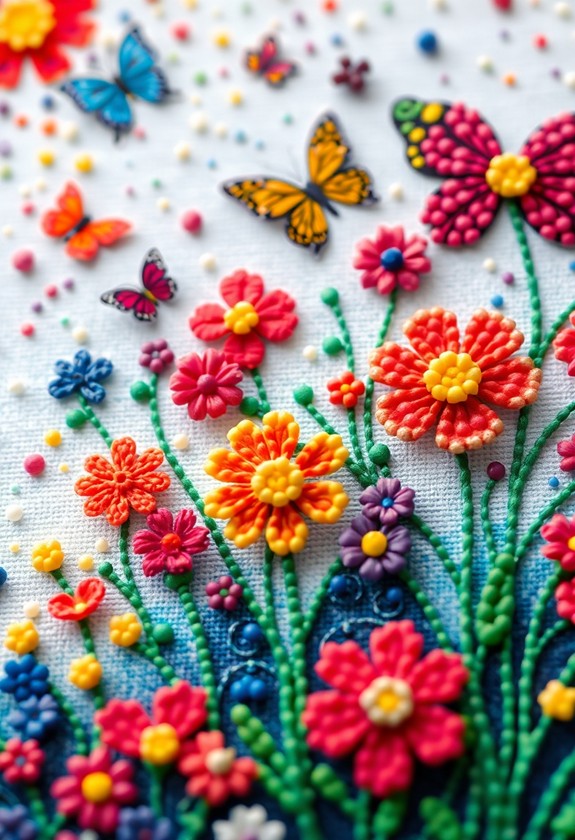
Q-tip pointillism paintings introduce toddlers to a unique art technique during the development of their fine motor skills. It's a fun, messy adventure that'll have your little one dotting with delight! Here's how to get started:
- Gather supplies: paper, washable paints, and Q-tips
- Squirt small dollops of paint onto a palette or paper plate
- Show your toddler how to dip the Q-tip in paint and make dots on the paper
Let their creativity run wild! They can create patterns, shapes, or just go dot-crazy. This activity is a real point-scorer for developing hand-eye coordination and grip strength. Plus, it's a great way to introduce color mixing – watch their eyes light up as dots of different colors blend together!
Curious Little Questions
How Can I Protect My Furniture and Floors During Messy Art Activities?
Protect your precious furniture and floors during messy art time with these awesome tips:
- Lay down old newspapers or a plastic tablecloth – it's a quick and easy shield!
- Use washable paints and markers – they're a parent's best friend!
- Dress your little artist in old clothes or a smock – fashion meets function!
- Set up a designated "art zone" away from carpets – contain the creativity!
- Keep wet wipes handy for quick clean-ups – be prepared like a scout!
With these tricks, you'll be ready to let those creative juices flow without worry!
What Age-Appropriate Safety Precautions Should I Take for Toddler Art Projects?
Safety first, art lovers! When creating with your little Picasso, you'll want to take some precautions. Here are some top tips:
- Always supervise your toddler closely
- Use non-toxic, washable art supplies
- Avoid small items that could be choking hazards
- Keep scissors and sharp tools out of reach
- Use smocks or old clothes to protect skin
- Have a first-aid kit handy, just in case
How Can I Encourage a Toddler Who Shows Little Interest in Art?
Don't worry if your little one isn't a mini Picasso yet! Here's how to spark their artistic side:
- Make it fun! Turn art into a game or silly activity.
- Try different mediums – finger paints, Play-Doh, or even food coloring in shaving cream!
- Get messy together! Your enthusiasm is contagious.
- Keep sessions short and sweet.
- Praise their efforts, not just results.
- Display their creations proudly.
Are There Any Art Supplies I Should Avoid for Children With Sensory Issues?
Picture a world of textures and sensations! For children with sensory issues, you'll want to avoid certain art supplies. Skip the gooey slime and sticky glue sticks. Instead, opt for smoother alternatives:
- Crayons with paper wraps
- Dry, soft pastels
- Colored pencils
- Washable markers
And don't forget about tools! Use scissors with spring-loaded handles and paintbrushes with chunky grips. Remember, every child is unique, so experiment to find what works best. It's all about making art fun and comfortable for your little Picasso!
How Often Should I Introduce New Art Activities to My Toddler?
Introducing new art activities to your toddler should be a fun, ongoing process! Aim to mix things up every 1-2 weeks, but don't worry about sticking to a strict schedule. Watch your little one's interest levels and adjust accordingly. If they're loving an activity, keep it going! But when boredom sets in, it's time for a fresh, exciting challenge. Remember, variety is the spice of life – and art! Keep things colorful, messy, and full of wonder to spark their creativity.

